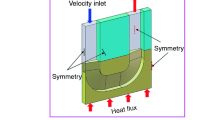Abstract
The orientation of the heat pipe plays the significant role in its performance. In specific orientations, the performance of the heat pipe is directly related to the wick structure. In conventional heat pipe, the working fluid is used a negative surface-tension gradient with temperature. It is an unfavorable one and it decreases the heat transport between the evaporator section and the condenser section. An Aqueous solution of n-Pentanol having a positive surface tension gradient with temperature is suggested as a working medium for heat pipe to improve the performance of capillary limit and operating stability. The objective of this paper is to perform a comparative study of heat pipe performance using the aqueous solution of n-Pentanol with water at various inclinations. The results are presented to demonstrate the merits and suitability of the aqueous solution of n-Pentanol as a working fluid for heat pipe.
Similar content being viewed by others
References
A. Faghri, Heat pipe Science and Technology, Taylor & Francis, Washington (1995).
S. W. Chi, Heat pipe theory and practice, McGraw-Hill, Washington (1976).
G. P. Peterson, An Introduction to Heat Pipes, Wiley and Sons (1994).
H. Bloem, J. C. De-Grijis and R. L. C. Devaan, An evacuated tubular solar collector incorporating a heat pipe, Philips Technical Rev., 40 (1982) 181–191.
M. P. Mughal and O. A. Plumb, An experimental study of boiling on a wicked surface, Int. J. Heat Mass Transfer, 39 (1996) 771–777.
A. Brautsch and P. A. Kew, Examination and visualization of heat transfer processes during evaporation in capillary porous structures, Appl. Therm. Eng., 22 (2002) 815–824.
S. Chandourene and A. Gruss, Theoretical and experimental study of high temperature heat pipe heat exchanger application to 1300kW respirator, Sixth International heat pipe Conference, Grenoffle, France (1987).
D. A. Littwin and D. B. Willis, The use of heat pipes to conserve energy in petroleum refineries, Energy Process (1985) 198–202.
F. Kaminaga, H. Hashimoto, C. Feroz, K. Goto and K. Masumura, Heat transfer characteristics of evaporation and condensation in a two-phase closed thermosyphon, Proc. 10th Int. Heat pipe Conf., Germany (1997).
S. Lin, P. A. Kew and K. Cornwell, Two-phase heat transfer to a refrigerant in a 1 mm diameter tube, International Journal of Refrigeration, 24 (2001) 51–56.
M. Esen, Thermal performance of a solar cooker integrated vacuum-tube collector with heat pipes containing different refrigerants, Solar Energy, 76 (2004) 751–757.
F. Song, D. Ewing and C. Y. Ching, Experimental investigation on the heat transfer characteristics of axial rotating heat pipes, International Journal of Heat and Mass Transfer, 47 (2004) 4721–4731.
Y. Xuan, Y. Hong and Q. Li, Investigation on transient behaviors of flat plate heat pipes, Experimental Thermal and Fluid Science, 28 (2004) 249–255.
L. L. Vasiliev, Heat pipes in modern heat exchangers, Applied Thermal Engineering, 25 (2005) 1–19.
L. L. Vasiliev, Micro and miniature heat pipes — electronic component coolers, Applied Thermal Engineering, 28 (2008) 266–273.
B. J. Huang, C. P. Lee and J. P. Chyng, Heat-pipe enhanced solar-assisted heat pump water heater, Solar Energy, 78 (2005) 375–381.
B. J. Huang and C. P. Lee, Performance evaluation method of solar-assisted heat pump water heater, Applied Thermal Engineering, 27 (2007) 568–575.
D. Liu, G. F. Tang, F. Y. Zhao and H. Q. Wang, Modeling and experimental investigation of looped separate heat pipe as waste heat recovery facility, Applied Thermal Engineering, 26 (2006) 2433–2441.
C. G. Ali and C. Cannistraro, The inclination effect on the performance of water filled heat pipe, Renewable Energy, 1(5/6) (1991) 667–674.
E. K. Levy, Theoretical investigation of heat pipes operating at low vapour pressures, Engg Ind., 90 (1968) 547–552.
N. Zhang, Innovative heat pipe systems using a new working fluid, Inl. Comm. Heat & Mass Transfer, 28(8) (2001) 1025–1033.
R. Vochten and G. Petre, Study of the Heat of Reversible Adsorption at the Air-Solution Interface, II. Experimental Determination of the Heat of Reversible Adsorption of Some Alcohols, J. Cillid and Interface Science, 42 (1973) 320–327.
A. Oron and P. Rosenau, On a nonlinear thermocapillary effect in thin liquid layers, J.Fluid Mech., 273 (1994) 361–374.
Author information
Authors and Affiliations
Corresponding author
Additional information
This paper was recommended for publication in revised form by Associate Editor Man-Yeong Ha
R. Senthilkumar obtained his Bachelor’s degree in Mechanical Engineering from Bharathiar University in 1994 and his Masters degree in Thermal Plant Engineering from Bharathidhasan University in 2002. He is currently working as an Assistant Professor in the Department of Mechanical Engineering at Annamalai University. He is on his way to obtaining his Doctoral Degree. He has two international and one national paper to his credit. His areas of interest include Heat transfer and Thermal Engineering.
S. Vaidyanathan obtained his Bachelor’s and Master’s Degree from Annamalai University. Masters Degree in Thermal Power Engineering in 1992 and Doctoral degree in Mechanical Engineering in 2005 from Annamalai University. He is currently serving as an Associate Professor in the Department of Mechanical Engineering at Annamalai University. He has a number of publications in National and International journals to his credit. His areas of interest include Heat transfer, Fluid flow and CFD.
B. Sivaraman obtained his Bachelor’s and Master’s Degree from Annamalai University. Masters Degree in Thermal Power Engineering in 1990 and Doctoral degree in Mechanical Engineering in 2007 from Annamalai University. He is currently serving as an Associate Professor in the Department of Mechanical Engineering at Annamalai University. He has a number of publications in National and International journals to his credit. His areas of interest include Heat transfer, Solar energy and Numerical Heat transfer.
Rights and permissions
About this article
Cite this article
Senthilkumar, R., Vaidyanathan, S. & Sivaraman, B. Performance investigation of heat pipe using aqueous solution of n-Pentanol with different inclinations. J Mech Sci Technol 25, 923–929 (2011). https://doi.org/10.1007/s12206-011-0207-4
Received:
Revised:
Accepted:
Published:
Issue Date:
DOI: https://doi.org/10.1007/s12206-011-0207-4




